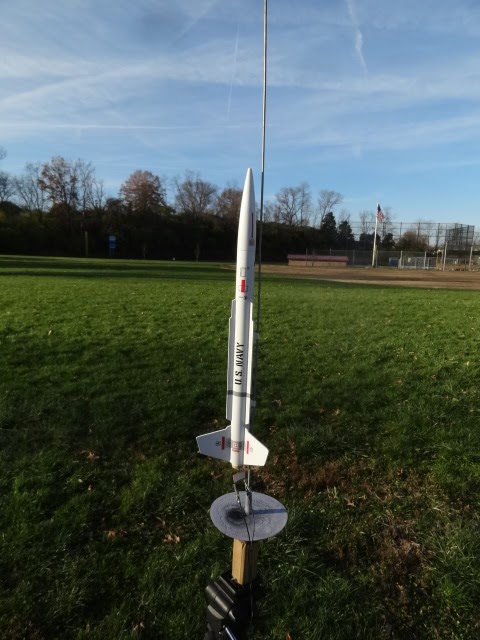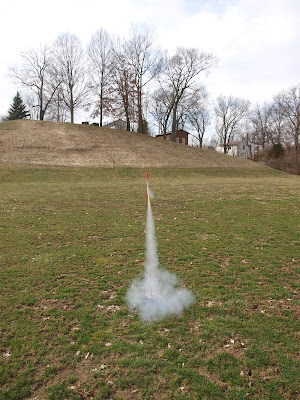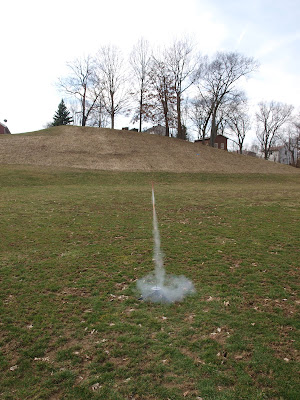Flight time has been at a premium for me in 2017, and flight time at B6-4 Field has been all but non-existent, so when the Sunday after Thanksgiving showed up in its 50 degree splendor without the always present wind, I leapt at the chance to fly some of the small field birds that clog my "unflown" list. Some of these are recent builds, but a couple pre-dated our move to the new house in 2005.
Speak of the devil, the Starlight F-32 Avenger was purchased right around the time of the move. Instead of waiting until we had settled in the new house to open and ogle the parts, I had to open them at the old house to inspect them. Somehow during the course of the move the fins disappeared. For a long time I had the body tube, engine mount and nose cone, along with the face card. One day it occurred to me that I could fake it, and this was the result. I also still have the sticker decals, which I plan to apply this week.
A8-3 for the first flight. It's a light rocket, and when I started there was something of a breeze, as the flag in the background shows. The F-32 Avenger windcocked to the left, then began drifting toward the trees at ejection. I never got concerned as it was obvious that it would run out of altitude before the trees became a problem.
Recovery was in deep left field on the line. Perfect flight and recovery to start, but it wouldn't last.
Second flight on the day would be my Custom Satellite Drone. I actually had to buy this one twice over the years because I screwed up construction on the first one. (Glued the fins on upside down while watching a football game. That one has yet to fly, but eventually will.) I loved how this one turned out.
As the flag attests, the breeze had gone elsewhere by the second flight of the day, and good riddance. The B6-4 was a perfect choice for conditions and the flight was fairly high and arrow straight. Recovery was an adventure as the chute came out at ejection, but only flapped as the rocket descended. I was cinched up for the inevitable damage that never came. The Satellite Drone made solid contact with the ground, but bounced off of a tuft of unmown outfield grass and incurred no damage. Chute and streamer issues would hound me all day.
Flight #3 was the Estes D.O.M. Loadlifter 1-A, one of my recent builds. I'd been having trouble trying to find something interesting from the Hobby Lobby hangers, so I took to the Estes Design of the Month plans for inspiration. I copied several birds that had an old school feel to them, and the Loadlifter 1-A was the first one I finished after ordering the parts from eRockets.
Since the Loadlifter 1-A turned out to be a fairly small bird and since I generally fly on a small field, I opted to go with mini-engine power. The Estes 1/2A3-2T was a great first flight choice, plenty of altitude, with the added bonus of an on-field recovery. Seeing this one fly has me thinking upscale, so that may be on my list for my next eRockets order.
This Custom Ion Pulsar is a replacement for my 2001 version that tried to take the launch pad with it on its one and only flight. That ended badly with parts and pieces all over a gravel parking lot. Damage was more than I was willing to attempt to fix, and I cannibalized it for parts. Years later I got a second one at a good price and decided to make up for the bad first flight.
The A8-3 flight was undoubtedly a bit conservative, but this felt lighter than the Satellite Drone. Flight pattern was almost dead on the previous rocket, the Loadlifter 1-A. I'm guessing that the slouch they both had on the pad and the breeze indicated by the flag in the background had some thing to do with it. Not terribly high, but recoverable, which is where I'm at these days.
Landed just up the hill from the Loadlifter 1-A landing spot. There was a moment when I was a little concerned by the tree limbs, but it cleared them with ten feel to spare. Great second flight, sixteen plus years later!
The Estes Astron X-Ray and I have a fairly checkered relationship dating back to 1978/79. There was a Rocket Red X-Ray, an ill-advised ball bearing launch from a church parking lot, and an ill-placed Plymouth Volare. Todays Rocket Red paint is a bit different than the one in my memory, and I can afford other colors, so the 2017 X-Ray only has Rocket Red as an accent color. I'm also not flying it on a C6-5. Yet.
The A8-3 flight was plenty for this field, and I didn't put anything in the payload section for this flight. As it was the flight was perfect, with light windcocking to the left, topping out around the 250' mark.
Of course, recovery had to be more interesting, although no Volares were present. There was a moment during this flight when I feared for the safety of the X-Ray, but it dropped harmlessly in deep left field, in the shadow of the trees, but safely out of their reach.
Far from a first flight bird, but not seen at the pads since 2013, the Goony Vector G has always had an issue with fins breaking off, even on a perfect parachute recovery. Since it's been my experience that Goony's tend to be a bit lethargic on A8-3 flights, I loaded it with a B6-4, which also happens to be the perfect motor for this bird.
Recovery was standard for the day, with the balled up chute fluttering behind the rocket acting as a half-wit streamer. The Vector G hit the ground butt first, and bounced. Sure enough, one of the newly replaced fins delaminated again. Chances are good that this rocket will require a replacement of the bottom body tube. It started out life as a pizza ad, but it was the only piece of cardstock I had handy on the day I caught Goony Fever.
The next flight set a personal record for me with two Starlight rockets flown in one launch. My previous high was none, so even I could figure that out. The Starlight Super Tiger had been around for a lot of years and had never flown, but had still come by a reputation as a bad luck bird. It was in my B6-4 Field Deluxe Flight Box one day, and actually made it to the field, but when I took it out to load a motor into it, I found a fin broken off. That damage was fixed, then another fin was broken when I set up the paint stick incorrectly after a primer coat. This launch day found it all in one piece, so it was brought along quietly as it apparently angers the rocket godz.
The flight itself didn't seem cursed at all, but that flag in the background should have been a clue to me as to what was to come. Despite the breeze, the flight was dead straight and the launch pic was one of the best I got all day.
No other recovery on the day was quite like this one. The A8-3 flight was quite a bit higher than I expected, probably due to the arrow straight flight path. At ejection it began racing toward the trees, which worried me at first, but then it became obvious that the trees were going to be the least of my recovery worries. I might have traffic to contend with.
There wasn't much I could do but walk and watch. The first thing I noticed was the sudden and complete absence of traffic. The second thing was that this would probably work in my favor because it looked like S. Ft. Thomas Avenue would be my landing site. Fifteen feet from touchdown the breeze died down enough that the parachute dropped slightly and nicked the branch of a fir tree in the parking lot of the office building at the intersection of S. Ft. Thomas and US 27. The Super Tiger dropped to the grass with maybe eight feet to spare. Couldn't have planned it better.
Flight #8 would be an oddball that, like the Super Tiger, was not yet out of the sanding stage. I'd gotten interested in the old Kopter Rockets plans at YORP. http://www.oldrocketplans.com/kopter/kop_RK05/kop_eagle.htm Three Kopter birds in particular caught my eye, the Hawk, the Eagle, and the XK-1, which in my mind equated to Kopter versions of the Estes Wizard, Alpha and Big Bertha. I ordered parts from eRockets, picked them up when I visited the shop for a Tuesday night build session, and actually had the Hawk ready to fly that night before I left for home. I forgot the Hawk when I was gathering small field birds for this launch, but I brought the Eagle, still covered partially in Fill & Finish.
The A8-3 flight was perfectly nominal, light windcocking on the way up, then a gentle recovery in deep left field. Now to just finish the tight job of sanding around those six fins and figure out a paint scheme.
The Semroc Nomad had flown previously, but never in full livery. (Well, almost full. There was an issue with one of the wrap decals.) Lots of decals with this one, but the single color paint scheme helps even things out.
A8-3 flight couldn't have been more routine. Slight windcocking to the left, as most of the birds did on this day, then a gentle recovery near the line in short left. Plus we get a bonus selfie.
The final flight of the day was actually two flights. The Semroc Baby Orion was a Christmas gift several years ago that had been built and flight ready for quite some time. The white paint was no trouble, but I couldn't decide on which blue would go best with the decals. Yeah, I was overthinking things. As it turned out, I just used some Arctic Blue Metallic that I'd had on hand for years, and it came out great.
The flight was a different matter. I had pre-loaded a couple of 1/4A motors with the intent of using them in the Estes Javelin and Super Flea, but both rockets needed masking tape to be friction fit. Yep, I forgot the masking tape. I grabbed a motor from the bottom of the box, not thinking that it was a 1/4A. The Baby Orion is small, but it is not a 1/4A bird. The flight was such that it barely cleared the rod and topped out at 15 to 20 feet. Ejection occurred on the ground just next to the pad and launcher. I scooped up the barely used wadding and reused it for a more respectable 1/2A flight.
The second flight was more like what I'd planned for the rocket, decent altitude and a perfect recovery in deep left. At this point in the afternoon, shadows were getting long and I was sure my wife would be getting hungry, so I packed up and left with a couple of bullets still in the chamber, which just gives me an excuse to sneak off to the field later in the week if the temps stay September-like.














































































